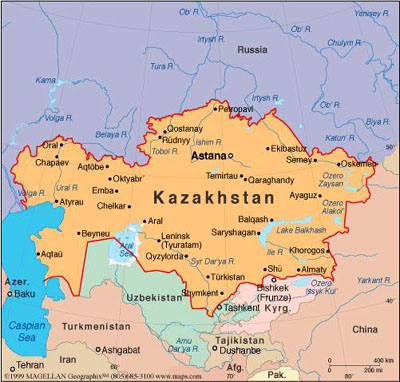|
Our
Beautiful World
|
Kazakhstan
Its People and its beautiful Nature
Part 2 - Its Nature

 There are 5 geographical regions in Kazakstan: : Western, Northern, Central, Southern and Eastern.  http://www.moveoneinc.com/blog/relocations/enrelocation-kazakhstan/ But if Kazakhstan traveler had turned slightly off the ancient caravan route and headed north, he would soon get a very different impression of the land where nearly every type of landscape that exists on our planet can be found. The poetic heritage of Kazakhstan people contains captivating pictures of the land with its broad expanses, the enormous bulks of snowcapped mountains and the azure mirrors of lakes. Image courtesy of Maxim Koshkin Only about 40 to 50 kilometers from the huge snow-white peaks rising in majestic succession, which look like the pyramids of the Egyptian pharaohs magnified many times, begins the boundless steppe, a pale yellow plain stretching to the very horizon. That is where you find the Social Lapwing bird at its breeding places at summer. Now let's have a look into the 5 different parts of Kazakhstan. Western region   
There are 4 provinces (oblasts) in West, one of them Aktobe, which are shown on these pictures. Courtesy: aboutkazakhstan.com The greater part of Aktobe oblast is a raised plain broken by river valleys. In the center of the region are Mugodzhar Hills, and in the south the desert sands of Aral Kara-Kum and Large and Small Barsuki. The climate of Aktobe region is continental, and precipitation
is low, particularly in the south. The river network of the  Horses in an oasis in Mangystau Horses - you find them everywhere in Kazakhstan. Photo: Gómanenko Roman, Courtesy: aboutkazakhstan.com Mangystau oblast is the land of ancient civilization, an archeological open-air reserve. In 1,000 B.C. the land of Mangystau was crossed by Great Silk way from Khorezm and Khiva to Europe and Middle East. Along this way on plateau Ustyurt there were fortresses, settlements of craftsmen, cattle-breeders and hunters. 
Even if this is a dry place, the tulips are still flowering here Photo: Kobdabayev Amangali Courtesy: aboutkazakhstan.com West Kazakhstan oblast, the last of four oblasts in the western region, lies mainly in Caspian Depression in dry steppe and semidesert zones. The capital city of the region is Uralsk Northern Region 
Kostanay scenery Photo: Sergey Likhota, Courtesy: aboutkazakhstan.com Kostanay oblast (other spellings are Qostanay, Qostanai, Kostanai, Kustanai or Kus-tanai) is located in the northern Kazakhstan, and is one of the two oblasts in this region. The capital city of the region is Kostanay. Kostanay oblast contains a portion of Turgay Lowland, which lies between the foothills of Urals mountains and Kazakh Uplands and connects West Siberian Plain in the north with Turgay Tableland in the south. 
Scenery from North Kazakhstan oblast Photographer unknown, Courtesy: aboutkazakhstan.com North Kazakhstan oblast includes steppe land, wooded in the northwest and the picturesque, hilly lake district in the south. The highest point of North Kazakhstan oblast is Mount Sinyukha, 3,107 feet (947 m), near Borovoye (health resort). North Kazakhstan oblast is located within forest steppe and steppe zones. About 8% of the territory is covered with forests, mostly birch-tree ones. Central region    Different Akmola oblasts sceneries. Photographers: Utkin Mikhail, Dmitry Sidorenko and Dmitry Sidorenko, Courtesy: aboutkazakhstan.com Akmola oblast (also spelled Akmolinskaya) is a region of Kazakhstan that lies in the steppe zone in the northwest Kazakh Upland and is drained by Ishim and Nura rivers. In the southwest of Akmola oblast there are lakes
Tengiz and Kurgaldzhin. The terrain of Akmola region is mainly rolling
There
are a lot of salt lakes (Zhaksy-Kykysh, Kamyslybas, Arys and others),
they often turn dry by summertime; there is In the center of Zhambyl oblast is the sandy Muyun-Kum
Desert, which is separated by Chu River from the clay desert We
feel we have given a fair picture of the nature of Kazakhstan, and
hope you agree that it is a beautiful country. |
 ANIMALS over 250 |
 BIRDS over 500 |
 FLOWERS over 225 |












